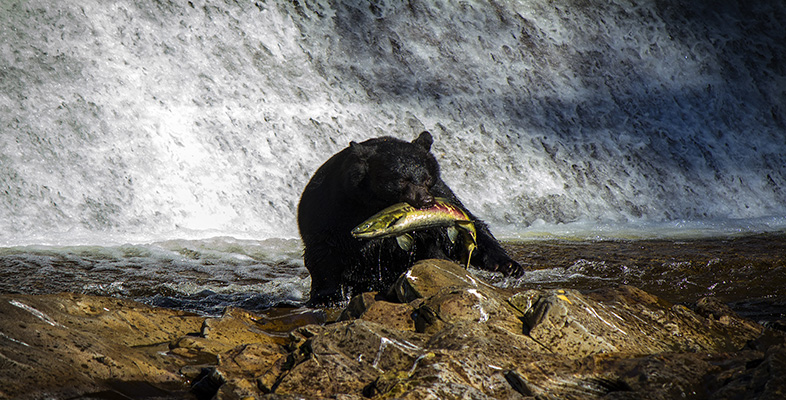2.2 Energy flow in ecosystems
You are about to meet some very large numbers, expressed in scientific notation, and some new units. The new units are those that are used to measure the amount of solar energy received by a part of the Earth's surface. Since plants are dependent on light for photosynthesis, the amount of plant material that can grow in a particular area depends, to a large extent, on how much solar energy reaches it. Energy is measured in joules (J) or, more often, in thousands of joules (kilojoules, kJ). The number of kilojoules received depends on the size of the area and the duration of the period of measurement. If we take an area of one square metre (1 m2) and measure the solar energy received during a whole year, then the units will be kJ per m2 per year, or more scientifically, kJ m−2 year−1. The 'year' is not strictly an SI unit and you may meet several different abbreviations, such as 'yr' (used in this text), 'y', or sometimes 'a', the abbreviation for 'annus' or, when preceded by 'per', 'annum'. Geological time is often quoted in Ma (millions of years).
An enormous amount of solar energy reaches the surface of plants, but most is reflected away and only a small proportion can be used by the plants for photosynthesis. The amount of solar energy falling on typical grassland is 7 × 106kJ m−2 yr−1 (i.e. 7000 000 kJ m−2 yr−1).
Question 2
Question: Of this large amount of solar energy, only a relatively small amount ends up in plant material - about 85 000 kJ m−2 yr−1. Express this value as a percentage of the total amount of incoming solar energy.
Answer
The units quoted here are identical (kJ m−2 yr−1), so you need to divide one measure by the other and multiply by 100, i.e.

In other words, the efficiency of energy conversion of the primary producers is only 1.2%. (Note that I initially retained the units as I set up this calculation, which is good scientific practice, but since they were the same at the top and bottom of the fraction, they must be cancelled and the final value is simply a percentage.)
Let's think more about the origins and fate of the food produced by plants via photosynthesis. Plants are not so much 'making' or 'producing' energy as 'converting' the energy of sunlight into chemical energy in the form of sugars - a biochemical trick that no animal can perform. So for plants, sugars are the initial products of photosynthesis; animals have to obtain these complex raw materials from their diet, and after digestion break them down into the smaller, usable chemical fragments, some of which are then metabolised to yield energy. In plants, some of the sugars produced go towards building up new plant material - forming, for example, the 'building blocks' for cellulose.
Other sugars in plants are broken down to yield the energy needed to sustain life processes - just one example is the energy needed to synthesise complex carbohydrates, such as cellulose. Energy that is used up in the plant's own metabolism in this way isn't 'locked up' in the form of the plant's cells and tissues, so is therefore not available to herbivores that might eat the plants. This 'lost' energy can no longer flow to the next trophic level. Another fraction of energy is lost as some plant tissues die - leaves in autumn, for example - and are subsequently consumed by bacteria and fungi.
Such energy losses mean that only a fraction of the material produced by photosynthesis in plants is eaten by the animals in the next trophic level - the herbivores, which comprise primary consumers. The transfer of energy to trophic level 2 is therefore limited. In our example, of the 85 000 kJ m2 yr−1 converted to plant material, only 39 000 kJ m−2 yr−1 may be consumed by the herbivores. But not all of this consumed food and energy can be 'captured' by herbivores and turned into herbivore flesh - the indigestible fraction ends up as faeces and a sizeable fraction is used to fuel the metabolism of the herbivores. In our case, about 6200 kJ m−2 yr−1 is captured by primary consumers, which leads to a calculation of trophic efficiency of herbivores (i.e. the fraction of energy locked up in their food that is converted into 'plant-eater flesh' of level 2 consumers) of (6200 kJ m−2 yr−1/39 000 kJ m−2 yr−1) × 100%=16%.
At each transfer between trophic levels, energy is lost. If only 16% of the food or energy taken in is converted into 'plant-eater flesh' then 84% of the energy is lost from the food chain. (Bear in mind that this energy isn't strictly speaking lost, in the sense of being destroyed - the law of conservation of energy, which you may have heard of, allows only its conversion to another form. What is meant here is simply that such energy is lost from the food chain - the lost energy pops up in another form and ultimately all of it is 'lost' as heat.) This loss of energy at each stage explains why there are tens of millions of plants in an ecosystem, but only thousands of herbivores and only tens of carnivores. In the vast areas of African grassland in Botswana, Kenya and Tanzania, huge grazing and browsing herds of herbivores can be maintained, but these support a much smaller number of meat-eating hunters. The proportion of energy flowing from one level to another is variable, but as a good rule of thumb we can think of 10% being transferred to the next trophic level, which helps explain why relatively few such levels are evident in ecosystems.
